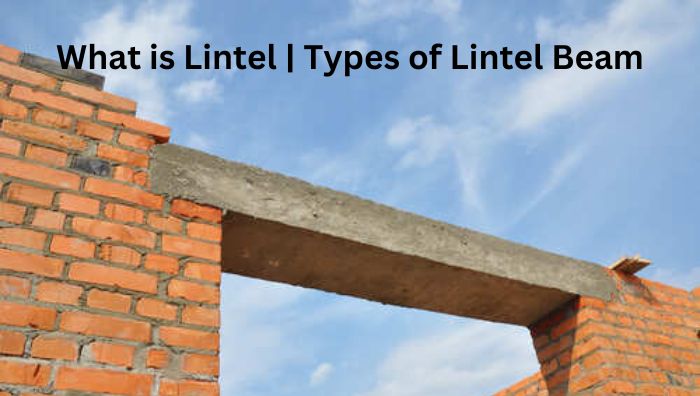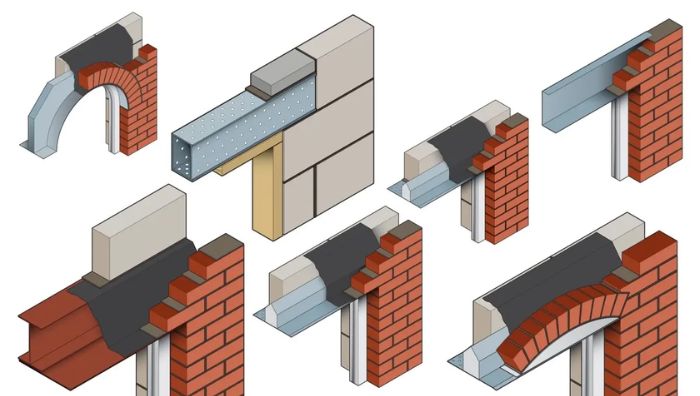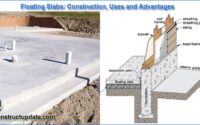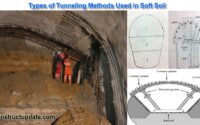What is Lintel in Construction | Types of Lintel Beam
What Is Lintel in Construction?
In building construction, a lintel is a kind of beam that crosses apertures such as windows, doors, or other architectural features. It is positioned horizontally to support and carry the weight of the structure above the entrance. By keeping the frames surrounding the aperture from collapsing, lintel designs equally distribute the load to maintain structural integrity. Depending on the precise structural requirements, lintel constructions might be formed of steel, concrete, wood, or bricks.
Functions Of Lintels
The following are the major functions of lintels:
Load distribution:
Lintels uniformly disperse loads across apertures like doors and windows from the structure above, including walls, floors, and roofs. Lintels ensure that there are no stress concentrations and that the building’s structural integrity is maintained by shifting the weight to the nearby walls or supports.
Structural support:
The structure needs lintel support to withstand the vertical stress that the roofs or walls above impose on the apertures. This support prevents the building area surrounding the entryway from deforming and safeguards against possible structural issues.
Reducing deflection:
Lintels distribute the load across a larger area, reducing the deflection or bending of the supporting parts. This ensures long-term stability and lessens the chance of deformation or cracking in the nearby masonry construction.
Visual appeal:
A building’s lintels enhance its visual attractiveness as well. They can be created to improve the overall facade or interior space design, as well as to blend in with the architectural style.
Size of Lintel Beam
The width of the lintel is typically equal to the thickness of the opening, and the depth falls between 1/12 and 1/8 of the building’s opening span when calculating the size of the lintel beam.
For every construction, a lintel must be at least 4 inches (100 mm) wide.
Different Types of Lintels in Construction
These are the various kinds of lintels that are employed in the building of various constructions.

Timber lintels:
These are used as beams or planks to build a horizontal load-bearing structure across openings such as doors and windows. They are made from hardwoods like oak or teak. Timber lintels are appropriate for modest spans and have a moderate load-carrying capacity. Their limited fire resistance and increased vulnerability to rot, rotting, and insect infestation over time limit their use.
Advantages of Timber Lintel
- Simple to construct.
- These can be used in makeshift constructions.
- No Formwork requirement
- No curing time.
Disadvantages of Timber Lintel
- Timber is rather pricey when it comes to the materials used to make lintels.
- Timber lintels can deteriorate over time if they are not properly maintained.
- It is vulnerable to fire damage.
- Permanent buildings are not suitable for the usage of timber lintels.
- Wood is unable to withstand the stresses of tension, compression, and shear applied to the lintel beam.
Stone lintels:
They offer remarkable endurance and visual appeal when carved into slabs of hardy natural stone like granite, limestone, or sandstone. However, because they require expert stonemasons and are labor-intensive, their use in modern buildings has waned. Furthermore, when used for longer spans or heavier loads, their low tensile resistance may cause them to shatter as a result of surface vibrations.
Advantages of Stone Lintels
- Stone lintels provide a pleasant appearance and an appealing appearance.
- These lintels are widely utilized since stones are readily available.
- They are suitable for usage in both transient and permanent constructions.
- No need for cure.
- Formwork is not required for these lintels.
Disadvantages of Stone Lintels
- The stone lintel has a low tensile strength.
- When exposed to seismic shock waves or vibrations, timber lintels are vulnerable to breaking and cracking.
- Stones are difficult to handle and carry because of their high weight and lower workability.
- Long spans cannot be covered by stone lintels.
Brick lintels:
They are created by lining up bricks in a particular arrangement to enclose window and door openings. To build a load-bearing structure, the bricks are put lengthwise or end to end and covered with mortar prepared with grey cement or Portland Pozzolana cement. Brick lintels are appropriate for small to medium-sized openings less than one meter in diameter and have strong compressive strength. Their capacity to support enormous loads, however, might not be sufficient for constructions with wider spans.
Advantages of Brick Lintel
- The price of bricks makes Brick Lintels a popular choice.
- The useful life of these lintel beams is limited.
- Due to their shared construction, the masonry and the lintel beam have the same thermal coefficient. Thus, it is possible to avoid fractures brought on by heat stress.
Disadvantages of Brick Lintel
- Tension cracks are common in bricks because of their weak tension.
- Only light weights can be supported by brick lintels.
- Long spans cannot be covered by a brick lintel.
- Formworks are needed as support during construction.
- A minimum of 14 to 21 days are needed for curing.
Reinforced brick lintels:
These are more developed types of brick lintels with more reinforcing for increased strength and capacity to support loads. To improve the structural integrity of the lintel, reinforcements in the shape of steel bars or rods are inserted into the brickwork during construction. This reinforcement keeps the brick construction’s visual appeal while greatly increasing the lintel’s capacity to support greater weights. When load demands are considerable and more strength is needed without sacrificing aesthetic appeal, reinforced brick lintels are used.
Steel lintels:

These can be built with single steel angles, channel sections, or rolled steel joists arranged in sets of two or three. Because of their remarkable strength-to-weight ratio, steel lintels can support heavier loads with more efficiency. They are often utilized in construction for a variety of apertures, particularly in situations involving greater spans or substantial load-bearing. Because steel lintels can be custom-fabricated, they offer flexibility in terms of both design and structural needs. Their superior load-bearing capacity and resistance to corrosion make them the material of choice for building projects that demand long-term stability and strength.
Advantages Of Steel Lintel
- Long spans can be covered by these lintels.
- Steel is easy to handle because it is lightweight.
- Steel is a versatile building material that is robust and long-lasting.
- Curing or formwork are not necessary.
Disadvantages Of Steel Lintel
- It tends to catch fire.
- It costs a lot.
Reinforced cement concrete (RCC) lintels:
To increase their load-bearing capacity, these are constructed with cement, aggregates, and reinforcement (steel bars or mesh). These lintels are meticulously crafted and cast to adhere to particular structural specifications. Excellent compressive and tensile strength, and resilience to weathering, fire, and moisture are all features of RCC lintels. From smaller windows to bigger entrances or structural openings in buildings, their great load-bearing capability and adaptability to many architectural concepts make them a popular choice in construction.
There are two main subtypes of RCC lintels:
Pre-cast lintels:
They are produced off-site in supervised facilities like casting yards or factories. After they are made, they are delivered to the building site and put right over the apertures. Precast lintels have fewer on-site labor requirements, faster installation times, and consistent quality.
Cast-in-situ lintels:
These are immediately produced within the building’s structural framework on the construction site. In this procedure, the apertures are covered with molds or formworks, and liquid concrete with reinforcing inserted into the formwork is poured into them. The molds are taken out after the concrete has dried and strengthened to the necessary degree. Cast-in-situ lintels provide design versatility, enabling customization for different-sized and shaped openings.




